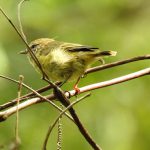YELLOW THORNBILL
Acanthiza nana
The Yellow Thornbill is a tiny bird, measuring about 9 to 11 cm in length. It has a predominantly olive-brown plumage, with a distinctive yellow patch on its cheek, giving it its name. Its tail is often held cocked, and it has a thin, pointed bill.
The Yellow Thornbill is endemic to Australia, and its range spans across much of the eastern and southern parts of the continent. They are found in a variety of habitats, including woodlands, heathlands, and suburban gardens.
These birds are active and agile foragers, often seen flitting about in shrubs and trees in search of insects and other small invertebrates. They also feed on nectar and can be found in flowers.
Yellow Thornbills are known for their high-pitched, melodious calls. They use these calls to communicate with other members of their group and establish territory boundaries.
Yellow Thornbills are social birds and are often seen in small family groups or mixed-species flocks. They are known for their cooperative behavior, with individuals working together to locate and catch insects.
Breeding typically occurs during the spring and early summer. The nest is a cup-shaped structure, often built in a dense shrub or tree. The female lays a clutch of eggs, and both parents share the responsibility of incubating the eggs and caring for the chicks.

